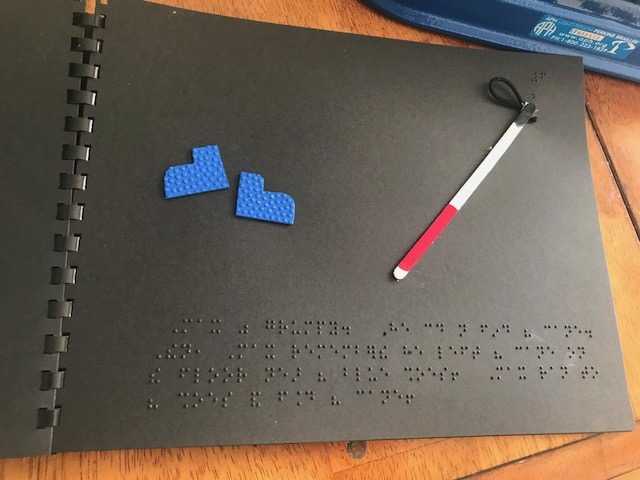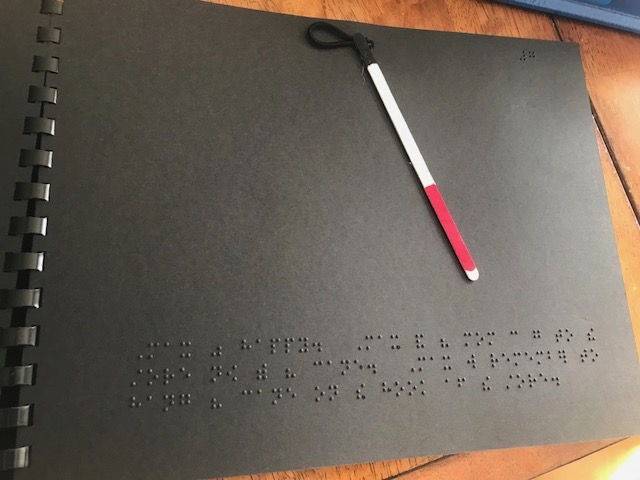I have a son, Liam, who is 8 years old. He is deafblind and a braille reader. He was born with typical vision and hearing. When he was 2 1/2 years old he became sick with meningitis. Due to complications from the meningitis, he became deafblind. Those first years he could see virtually nothing except for light and dark. As the years went on his vision gradually improved. He can now see movement, some shapes and some colors. He still cannot not see things clearly. He uses a cane to navigate at school and outings, he reads and writes using braille, and he uses tactile American Sign Language (which means receptively he needs to “feel” the signs of others). It has been speculated that he has CVI (cortical visual impairment) and currently we are in the process of testing and evaluating him for that. Over the past year or so he has been using what vision he has more and more. He frequently inquires about the colors of objects and clothing; he is very curious about color. I wanted to use this new “obsession” with color and create a book that is for children that may have CVI and can see color. I also wanted a book that has a character who is blind — just like my son — and is someone he can instantly relate to.
My first attempt at a book for children with CVI is a fictional book about an 8-year-old boy whose name is Max. Max is ready to go to the store with his mom, but has misplaced his cane. Throughout the book he searches his home for his cane. I purposely chose black cardstock paper to make the book so that the graphics would stand out better. I made the book for a child who is a braille reader, but who can make out some colors and simple shapes. The graphics have a tactile appeal as well. I specifically chose words that would address positional concepts, feeling words, and colors. There is also an underlying theme of “putting your things where they belong so that you can find them again”. Being organized is especially important for children with vision impairments.
Modifications:
What I love about this book is that it could be easily modified for any child with vision impairments! The vocabulary could be altered slightly to fit your learning goals for your child and fit their interests. You could change the braille to large print if that is what best fits the needs of your child. The graphics are appropriate for children who need tactile graphics as well.
Objectives:
Positional Concepts:
- on
- under
- near
Colors:
- red
- yellow
- white
- blue
Vocabulary about Feelings or Emotions:
- frustrated
- sad
- mad
- grumpy
- happy
Theme:
- everything has a place
Materials:
- Black card stock paper
- Tactile graphics: random materials that are ‘fun’ to the touch and also match the appropriate colors that go with the story (for example, white fabric for the T-shirt).
- Skinny popsicle sticks for the cane. I found mine at Hobby Lobby and painted them myself. I cut up one of my hair ties for the loop on the cane.
- Hook: I found the smallest hook I could find (They can be found at any store. I think I got mine at Target or Walmart.)
Max and His Cane
By Sandy Kenrick
Max was 8 years old. He wanted to go to the store. His mom told him first he needed to find his cane and then they could go.

Max walked over to the door. His cane is usually hanging on a hook that is attached to the door. Max felt for his cane and noticed that it was not hanging on the hook. Where was his cane?

Max was frustrated he could not find his cane. He walked over to the table and checked under the table. His cane was not there but he found his red ball!

Max was sad he could not find his cane. He walked into the kitchen. He felt the kitchen counter. His cane was not there but he found his yellow cup!

Max was mad he could not find his cane. He walked into his bedroom and looked under his bed. His cane was not there but he found his white shirt!

Max was grumpy. He could not find his cane. AHA! Max remembered he left his cane on the floor near his blue shoes! Max ran to his shoes and found his cane!

Max was happy. Max and his mom can go to the store now with his cane. Max will remember to hang his cane on the hook after the store.







